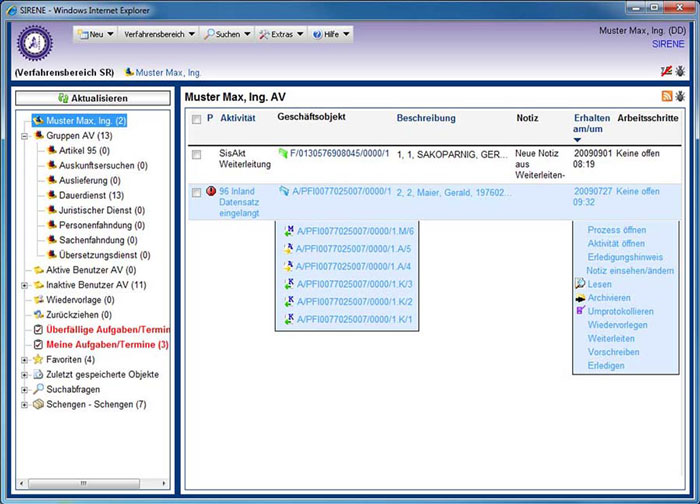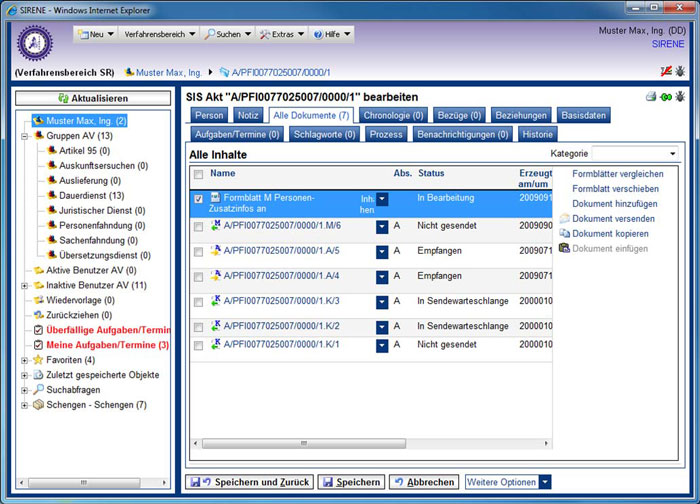Customer

With a workforce of around 700 employees, the role of the Federal Criminal Police Office is to combat crime nationwide and serve as a centre for cooperation with international police functions. Cross-border search data is exchanged via the Schengen Information System.
Highlights
- Complete replacement of the existing software
- Electronic forms for search data
- File-sharing between offices
- Communication via complex, specified interfaces
Initial situation: The technological basis needs to be replaced
Police departments and justice authorities in all Schengen member states use the Schengen Information System (SIS) to exchange the data of persons wanted or missing and of stolen property in connection with international search efforts. Each member state has a so-called SIRENE coordination office (Supplementary Information Request at the National Entry) that is responsible for its SIS node and therefore needs to run reliably within the pan-European network.
The international conversion to the second generation of the Schengen Information System (SIS II) required a comprehensive redesign and expansion of the IT systems at the Austrian SIRENE office located at the Federal Criminal Police Office. The technological basis was outdated and unable to fulfil the requirements of SIS II. It was therefore necessary to replace it entirely whilst maintaining compatibility with the previous standard SIS I+.
The solution: Acta Nova as a basis for the new SIRENE software
RUBICON submitted the best bid for the SIRENE project and emerged from the call for tender as the winning contractor. As RUBICON was already a proven provider to Austria’s federal government at this time, it was able to demonstrate considerable experience in the segment. Electronic forms for logging search data, file transfers between offices, communication via specified interfaces – the SIRENE project was, to all intents and purposes, all about electronic file management.
Our standard product Acta Nova tipped the scales in our favour. It contains many of the functions needed to develop electronic file systems and therefore reduced the amount of work and the overall cost by more than one half.
The challenges
The deadlines were extremely tight and linked to international milestones. In addition, one of the key requirements was that the Austrian implementation of SIRENE for SIS II had to be converted from the existing SIS I+ format to the new SIS II format by a specified deadline within a very short period of time. Without Acta Nova it would not have been possible to adhere to the tight schedule with a completion time of 12 months, nor would it have been possible to guarantee the stability of the application and the complex interfaces.
Add to this the fact that the SIS II specification, or the technical rules, had not been tried in practice. RUBICON was the first company in Europe to complete implementation and, in doing so, test the system’s suitability for purpose.
The improvements developed by RUBICON and the Austrian SIRENE office flowed back into the SIS II specification and have had a significant influence on implementation in other Schengen member states. We received many enquiries from other participating countries due to our pioneering role.
Furthermore, data volumes amounting to 40,000 files with a total of 300,000 forms had to be migrated from the existing SIS to the new standard.
SIRENE Austria ready for SIS II
The system was ready for operation as scheduled after 7 hours of data conversion in January 2009. This made Austria one of the first Schengen member states to be ready for SIS II. However, as there was no productive central SIS node for international data exchange in place at the time, it took until April 2013 until the Schengen Information System of the second generation could be taken into operation.
The conversion to SIS II worked well across Europe. All police departments and customs checkpoints can use the new person search system and exchange information more quickly.
Expanding person-related search options
The technologically modernised SIS II now makes it possible to store biometric data such as fingerprints and photographs. Manhunts in the Schengen zone have improved as a result. The list of property searches was also expanded. File management and communications with national and international departments are now conducted via a specialised application based on Acta Nova that has been optimised for locating wanted persons.
“The experiences gained during the development of the SIRENE application for the former SIS I+ and the close cooperation in the international work groups for SIS II made it possible to develop a software programme oriented on the needs of the users”, sums up RUBICON project manager Thomas Wundsam.
Facts & Figures
- 1.2 million person-related searches, 45.9 million property searches, 300,000 searches from Austria
- Migration of 40,000 files with 300,000 forms
- 1,000 man-days, of which 600 were purely for software development
- Duration: 12 months
Technologies
- Acta Nova
- Windows Server
- MS SQL
- Silverlight

